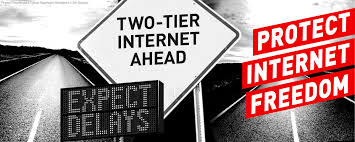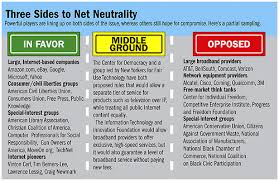
Net Neutrality
(parts of this lesson courtesy: PBS Learning Media)
Grades: 9-12
Content: Broadcasting, Web Design, Journalism
PURPOSE: By the end of this lesson, students will:
- Be able to explain the issue of Net Neutrality.
- Watch a video and conduct Internet research to identify specific arguments for and against Net Neutrality legislation.
- Write a persuasive one-page editorial that takes a position in the Net Neutrality debate.
Language Arts standards:
Source: “Content Knowledge” (http://www.mcrel.org/compendium/browse.asp) by McRel (Mid-continent Research for Education and Learning)
Civics
Standard 13: Understands the character of American political and social conflict and factors that tend to prevent or lower its intensity.
Standard 28: Understands how participation in civic and political life can help citizens attain individual and public goals.
Economics
Standard 4: Understands basic features of market structures and exchanges.
Language Arts
Standard 1: Uses the general skills and strategies of the writing process.
Standard 4: Gathers and uses information for research purposes.
Standard 9: Uses viewing skills and strategies to understand and interpret visual media.
Standard 10: Understands the characteristics and components of the media.
U.S. History
Standard 31: Understands economic, social, and cultural developments in the contemporary United States.
Assignment:
Write a persuasive one-page editorial that takes a position in the Net Neutrality debate.
Time:
45-minute class period
Materials:
iPad, Google Classroom, internet, and handout
- Method (varies by school) of showing the class a video clip and reviewing other resources from the MOYERS ON AMERICA Web site.
- Handout: Editorial Prewriting Worksheet (PDF file)
Prior Knowledge:
Students should have experience using the internet for research purposes and should be familiar with the structure and purpose of editorials.
Teaching Strategy
- Ask students to provide examples of how they use the Internet. List responses on the board.
- Point out that some activities listed (e.g., watching video) demand a more robust Internet infrastructure than other activities (e.g., sending a text email). Explain that such varied demands on the Internet’s infrastructure have triggered a debate about ‘Net Neutrality,’ an issue rooted in how content should be delivered to consumers. In a nutshell, companies that provide ‘high speed’ or broadband networks (i.e., phone company DSL or cable Internet services) want to be able to charge higher fees to those who send data-heavy content on the Internet in return for getting that content to consumers faster than the content of individuals or companies who don’t pay the higher fees. Broadband network providers say it’s only fair that those who place a greater demand on the network should pay more. Critics of this approach believe that such a tiered system would limit the ‘openness,’ ‘freedom’ and ‘neutrality’ of the Internet because not all content providers would be able to reach consumers on a level playing field; those with money would be given an unfair advantage. Some also worry that network providers might block or censor some people’s content.
- Show students a 3:28 video clip on the Net Neutrality debate from the MOYERS ON AMERICA “Net at Risk” program. As students watch, have them list the concerns shared by those featured in the clip.
- Discuss the following: Based on the information in the video, how has the Internet influenced the democratic process? Why is Net Neutrality such an important issue to Joan Blades of MoveOn and Michelle Combs of the Christian Coalition? Why does Mike McCurry, a lobbyist for broadband network providers, think government regulation isn’t necessary?
- Explain to students that they will dive deeper into the Net Neutrality debate as they conduct research and develop persuasive one-page editorials that express their positions on this issue. Then, distribute copies of the Editorial Prewriting Worksheet and point students to the following sections of the MOYERS ON AMERICA Web site:
Net Neutrality overview
http://www.pbs.org/moyers/moyersonamerica/net/neutrality.html
Quotes from those in favor of and opposed to Net Neutrality legislation
http://www.pbs.org/moyers/moyersonamerica/net/documents.html#debate
Summary of arguments from those for and against Net Neutrality
http://www.pbs.org/moyers/citizensclass/the_net_risk/net_neutrality/
- Based on the abilities of your students, provide a deadline for completing the editorials and collect them at the appropriate time.
Assessment Recommendations
Check student understanding of the concepts in this lesson by:
- Providing a short-answer question on your next exam that asks students to briefly explain the issue of Net Neutrality.
- Grading the format and content of the persuasive one-page student editorials.
Extension Ideas
- Have students present their editorials and participate in a peer evaluation process. Such presentations and evaluations could take place one at a time before the class, or in small groups of 5-6 students.
- Invite students to share their perspectives on Net Neutrality more broadly by sending their editorials to their elected representatives or to a newspaper. Students could also produce podcasts to deliver audio versions of their editorials on the Internet. For students who do podcasts, ask them how a tiered system of Internet content delivery could potentially affect their ability to share such podcasts.
- Another topic addressed by the MOYERS ON AMERICA “Net at Risk” Web site is media consolidation. Explore this topic by first discussing the role of media in a democracy. Then, examine the graphic, “Who Owns the Media” (http://www.pbs.org/moyers/moyersonamerica/net/index.html), which outlines the holdings of the top six media companies. How might consolidated media ownership influence how media carry out their role? Have students research examples of such influence and present their findings. What implications might this situation have for democracy?
- The MOYERS ON AMERICA Web site for the program “The Net at Risk”
(http://www.pbs.org/moyers/moyersonamerica/net/index.html) includes four Citizens Classes that provide in-depth information and discussions on, “The New Digital Divide,” “Net Neutrality,” “Community Connections” and “Big, Bigger, Biggest Media.” Explore these topics in small groups and have students contribute to the online Class discussions.

Related Resources
Online NewsHour: Net Neutrality Analysis
http://www.pbs.org/newshour/bb/media/jan-june06/netneutrality_06-22.html
This June 2006 interview from The NewsHour with Jim Lehrer presents arguments from both sides of the net neutrality debate. How to Write an Editorial
http://www.courses.rochester.edu/brickman/cas105/Editorial.html
This concise resource provides some general tips and a common structure for writing editorials.
About the Author
Cari Ladd, M.Ed., is an educational writer with a background in secondary education and media development. Previously, she served as PBS Interactive’s Director of Education, overseeing the development of curricular resources tied to PBS programs, the PBS TeacherSource Web site, and online teacher professional development services. She has also taught in Maryland and Northern Virginia.

What is “net neutrality?” Here’s what you need to know in plain English.
Give me a definition of net neutrality in plain English.
“Net neutrality” prevents Internet providers like Verizon and Comcast from dictating the kinds of content you’re able to access online. Instead, Internet providers have to treat all traffic sources equally. Net neutrality is enforced by the Federal Communications Commission, or FCC.
For example, Comcast would probably like to promote NBC’s content over ABC’s to its Internet subscribers. That’s because Comcast and NBC are affiliated. But net neutrality prevents Comcast from being able to discriminate, and it must display both NBC’s and ABC’s content evenly as a result. That means no slower load time for ABC, and definitely no blocking of ABC altogether.
In short, net neutrality creates an even playing field among content providers — both large and small — to the web. And it’s great for consumers because they can access everything they want online for no extra charge.
Right now, consumers control what they see online — not Internet access providers — and that’s thanks in large part to net neutrality.
ADAM RUINS EVERYTHING https://youtu.be/xjOxNiHUsZw
WHY IS THE INTERNET SLOW? https://youtu.be/Jgox_RR6bNE
Net neutrality sounds nice. Who’s against it?
Some big Internet providers like Verizon don’t like the idea of net neutrality. They feel they should be able to pick and choose what people see online and charge content providers accordingly. They feel net neutrality chokes their revenue potential.
Imagine if Verizon has tiers of Internet access. The highest paying customers could access everything on the web. The lowest paying customers could access only the information Verizon chooses to promote. Verizon could even charge web publishers like NBC and ABC to display their content over competitors.
Think of it like Google ads. When you type in a search on Google, the top links are all from advertisers who pay Google to put their messages up top. Getting rid of net neutrality means Verizon or Comcast could similarly choose which content to promote based on their own self-interests.
Why did net neutrality largely get shut down yesterday in court?
The court’s decision yesterday rests on a decision the FCC made back in 2002.
In 2002, the FCC decided Internet access providers should be regulated differently than phone companies. Phone companies have been regulated by the FCC for the past 80 years to keep them from favoring certain conversations or “discriminating when selling services,” Harvard professor Susan Crawford tells Re/Code.
Phone companies are telecommunications services, but the FCC viewed Internet providers as information services. Because the FCC deemed the two types of companies to be fundamentally different, the FCC decided to not regulate Internet providers at all.
Recently, however, the FCC became concerned that a few Internet providers have grown too powerful. For example, in 2007, Comcast got in trouble for blocking BitTorrent’s access to its network. The FCC didn’t want the Verizons and Comcasts of the world to become the gatekeepers of the web.
So in 2010, the FCC created something called Open Internet Rules which enforced three things:
- Internet access providers had to start disclosing how they were managing their networks.
- No blocking. Internet access providers couldn’t block access to legal content or applications.
- No discrimination.Essentially, net neutrality. Internet access providers couldn’t favor one traffic source over another.
Verizon challenged the Open Internet Rules because they contradicted the FCC’s 2002 decision not to regulate Internet service providers. It said, by enforcing Open Internet Rules, the FCC was trying to regulate companies like Verizon. The court agreed, saying, “even though the Commission has general authority to regulate in this arena, it may not impose requirements that contravene express statutory mandates.”
Will consumers benefit from getting rid of net neutrality?
They could. Getting rid of net neutrality would allow the Verizons and Comcasts to charge content providers who want their stuff promoted. The additional revenue stream might mean free data plans for consumers. Never paying for a data plan again sounds pretty nice.
Could getting rid of net neutrality screw consumers?
It could. Consumers might lose control of the Internet; Verizon and Comcast could be the masters who dictate exactly what we’re able to view online. There’s also a risk for small businesses. If they can’t afford to pay Internet providers to promote their content, they might go under.
So, what does this mean for all of us moving forward?
In the absolute worst-case scenario, we could be looking at a sponsored Internet in the future, where the only things Verizon or Comcast subscribers see is the information those providers want them to see.
That means small businesses, who can’t afford to pay providers like Verizon or Comcast to promote their content, might die, and only larger companies who can afford to pay will have their content spread across the web.
“In all likelihood the Internet will gradually move from being a one-size-fits-all service to one where users or content companies can — or have to — pay more for better service or higher volumes of traffic,” The Wall Street Journal writes.
It’s unclear what, exactly, Verizon and Comcast plan to do with their newfound freedom.
Keep in mind, the FCC may appeal the court’s decision so there’s still a chance that net neutrality comes back into play. This ruling is likely just the tip of the iceberg.
But as BuzzFeed’s John Hermann says, this could mark the beginning of Internet 3.0.
Business Insider:
http://www.businessinsider.com/net-neutralityfor-dummies-and-how-it-effects-you-2014-1
Details explained:
